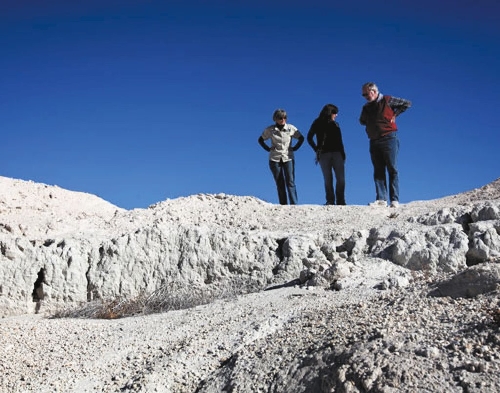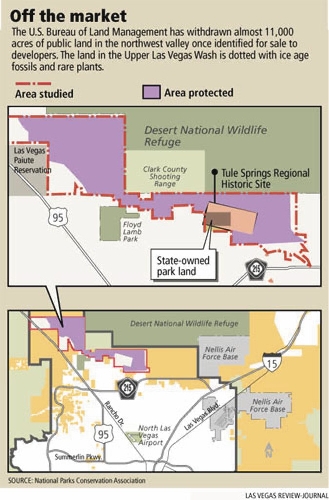BLM moves to protect fossils in Tule Springs area
No homes will be built on top of the mammoths of Tule Springs anytime soon.
The U.S. Bureau of Land Management announced Friday that it won't allow the auction of almost 11,000 acres of fossil-rich federal land at the valley's northern edge.
Tule Springs and the Upper Las Vegas Wash are dotted with ice age fossils and rare plants.
Conservationists hailed the decision as a first step in securing the area until it can be designated as a national monument.
"This is an important day for conservation," said Rob Mrowka, a Nevada-based ecologist with the Center for Biological Diversity. "These lands are truly the last remaining opportunities for preserving and protecting the natural heritage of the Las Vegas Valley."
The Arizona-based environmental group has joined with the local Protectors of Tule Springs and others to push for the creation of a 23,000-acre Tule Springs National Monument that would border Las Vegas, North Las Vegas, Floyd Lamb Park and the Desert National Wildlife Refuge.
The proposed monument would take in a sawtooth-shaped swath of land that includes areas littered with the fossils of animals that lived and died between 7,000 and 200,000 years ago.
Three rare plants native to the Mojave Desert -- the Las Vegas bearpoppy, Merriam's bearpoppy and the Las Vegas buckwheat -- also are found there.
The Center for Biological Diversity has petitioned for the Las Vegas buckwheat to be protected under the Endangered Species Act.
In a summary of its decision published Friday morning in the Federal Register, the bureau said 10,670 acres of public land would be withdrawn from possible disposal to protect sensitive features "including fossils, cultural resources, the natural functioning of the wash, and endemic plants."
Mrowka called the news "a vindication for those of us who were shocked in 2004 to learn the BLM was going to actually auction off those lands for development."
He and others say the next step is for the land to be placed under the protection of the National Park Service.
Lynn Davis is program manager for the Nevada office of the National Parks Conservation Association. She wants the Park Service to manage the Upper Las Vegas Wash in part because that probably would block NV Energy from building a new transmission line through the proposed monument.
"While the BLM's decision has stopped plans to allow for the construction of homes over irreplaceable fossils, it's a far cry from providing the protection and enhancements that would come with a National Park Service designation," Davis said in a statement.
Backers insist legislation concerning Tule Springs is imminent. All Sen. Harry Reid's office would say is the Senate majority leader still favors the idea.
"Sen. Reid supports efforts to designate the Tule Springs area a national monument and hopes to work with the Nevada delegation to do so," Reid spokeswoman Kristen Orthman said.
Gov. Brian Sandoval and leaders in Las Vegas, North Las Vegas and Clark County also have thrown their support behind the creation of a monument. So has the U.S. Air Force, which wants the area protected as a flyway for Nellis Air Force Base.
The land skirts the northwestern boundaries of Las Vegas and North Las Vegas and wraps around the Clark County Shooting Range. It is hemmed on one side by the Sheep Mountains and on the other by rows of houses marking the edge of development.
The landscape in between forms chalky white badlands cut by the braided wash bed and strewn with fossilized bones from mammoths, camels and early horses. A former paleontologist for the National Park Service estimates at least 10,000 mammal fossils from the past several ice ages await discovery in the Upper Las Vegas Wash.
There are signs of disturbance everywhere.
Tracks from dirt bikes and other off-road vehicles crisscross the hills -- rolling, in some cases, directly across the old bones of ancient animals. Broken glass sparkles in the sun. A row of NV Energy transmission towers marches from west to east through the heart of the property under a sky split by military jets and helicopters.
The BLM based its findings on a final environmental impact statement that also was released Friday after several years of study and public input.
Under the decision, which does not take effect for at least 30 days, almost 2,700 acres within the roughly 13,000-acre study area could be made available for development. The largest parcels identified for disposal bracket the Las Vegas Paiute Indian Reservation on U.S. Highway 95 northwest of Las Vegas.
Mrowka said the collapse of the housing market has quieted calls for more public land to be auctioned and new subdivisions built. But the lull in Las Vegas is not expected to last forever.
Mrowka said the BLM deserves credit not only for this decision but for an overall change in attitude about Tule Springs.
Back when the land appeared destined to be covered with homes, the bureau "didn't give two hoots in hell" about the Upper Las Vegas Wash, he said. Now the site is fenced and regularly patrolled.























